Isn't the data buffered in the DAC? If it is buffered, what timing issues would there be from the stream - since the audio is generated from the buffer not directly for the stream?
DAC Connections: Asynchronous USB Input vs. Ethernet

Q Can you explain what it is about an asynchronous USB DAC input on a receiver that would enable it to sound superior to an Ethernet connection streaming the same file over a home network? —Chris Hebner / Delano, MN
A The oft-stated advantage of an asynchronous USB connection is that it lets the clock present in the DAC control the flow of audio data from the computer, as opposed to sharing that task with your PC or Mac. By commandeering the data flow, asynchronous USB eliminates timing errors that can potentially degrade audio performance. You can still expect good sound when using an Ethernet connection to stream audio to a receiver from your computer, however. The key issue with that connection isn’t so much sound quality but ergonomics. By using an Ethernet cable to link the AV receiver to a home network, your computer (or NAS drive) can be located far away from the theater or listening room. With a USB hookup, on the other hand, your computer generally ends up in the same room as the audio system, an arrangement that some listeners may find less than ideal.
- Log in or register to post comments


I saw this question in the Sound & Vision newsletter and thought great, I'm not the only one with this question. Then I click on the link and see it was actually in response to my question. Thank you!!
Like you mentioned in your response I am in the group of listeners where my computer is no where near my audio system. I am very satisfied with the sound quality I get streaming FLAC files (mostly from CDs, but some higher resolution) over the Ethernet connection. It's tough to do A/B comparisons between the Ethernet connection and my disc player (Oppo BDP93 connected to Integra DHC 80.3 via HDMI) but in the comparisons I've done I don't know that I'd be able to tell the difference in a blind comparison test.
I have no plans to upgrade my pre/pro anytime soon, but I've thought of moving my music closer to my audio system, maybe building a small music server to sit next to my audio rack. What kind of improvements will be gained by using an asynchronous DAC to control the timing vs the computer? I understand the technical aspects that timing errors may occur when using an Ethernet connection, but what sort of impacts could that have on the sound I am hearing? What sort of improvements am I likely to hear?
Thanks again!

The question itself starts from a complete misunderstanding, which two people answering have failed to even spot. A DAC doesn't connect to the network, so doesn't even know what "ethernet" is. It's not a question of ethernet "or" asynchronous USB. You could have both. These are two totally separate parts of the chain.
The first stage is to get the file to your audio player (e.g. Squeezebox, or whatever) from your PC or NAS. This can be via ethernet or wireless. (Alternatively, I use a Squeezebox Touch in standalone mode, with HDD directly connected; no PC or NAS involved.) Either way, the player will buffer the data in its own memory. You are simply transferring the file/data from one storage medium to another. You could send the file halfway round the world before it arrives at your player and it still wouldn't degrade. Ever downloaded audio files over the net? Do you think they degrade if downloaded from a country far away? Of course not. Internet radio is another case in point.
The next stage is to send the data from the player to the DAC. This is the bit that, until recently, was fraught with timing issues (jitter) due to antiquated methods of data transfer and DAC technology. An asynchronous USB connection solves this problem, and the data transfer should be just as lossless and bit-perfect as, say, sending a file over the internet.



































































